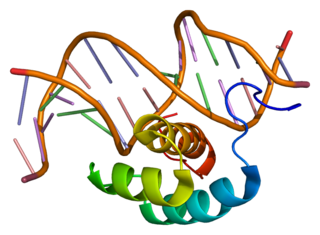Iroquois-class homeodomain protein IRX-5, also known as Iroquois homeobox protein 5, is a protein that in humans is encoded by the IRX5 gene. [3] [4]
Iroquois-class homeodomain protein IRX-5, also known as Iroquois homeobox protein 5, is a protein that in humans is encoded by the IRX5 gene. [3] [4]
IRX5 is a member of the Iroquois homeobox gene family. Members of this family appear to play multiple roles during pattern formation of vertebrate embryos. [3] First described in a 2012 study by Reversade and colleagues, the loss of IRX5 in humans causes Hamamy Syndrome, a recessive developmental disorder mainly affecting the heart, long bones, and craniofacial structures. [5]

Tumor protein p63, typically referred to as p63, also known as transformation-related protein 63 is a protein that in humans is encoded by the TP63 gene.

Homeobox protein MSX-1, is a protein that in humans is encoded by the MSX1 gene. MSX1 transcripts are not only found in thyrotrope-derived TSH cells, but also in the TtT97 thyrotropic tumor, which is a well differentiated hyperplastic tissue that produces both TSHß- and a-subunits and is responsive to thyroid hormone. MSX1 is also expressed in highly differentiated pituitary cells which until recently was thought to be expressed exclusively during embryogenesis. There is a highly conserved structural organization of the members of the MSX family of genes and their abundant expression at sites of inductive cell–cell interactions in the embryo suggest that they have a pivotal role during early development.

Homeobox protein MSX-2 is a protein that in humans is encoded by the MSX2 gene.

Cone-rod homeobox protein is a protein that in humans is encoded by the CRX gene.

Fibroblast growth factor 8(FGF-8) is a protein that in humans is encoded by the FGF8 gene.

Homeobox protein engrailed-2 is a protein that in humans is encoded by the EN2 gene. It is a member of the engrailed gene family.

Homeobox protein Hox-A7 is a protein that in humans is encoded by the HOXA7 gene.

Homeobox protein Hox-A13 is a protein that in humans is encoded by the HOXA13 gene.

Zinc finger homeobox protein 3 is a protein that in humans is encoded by the ZFHX3 gene.

Homeobox protein Hox-A3 is a protein that in humans is encoded by the HOXA3 gene.

Paired related homeobox 1 is a protein that in humans is encoded by the PRRX1 gene.

Homeobox protein CDX-1 is a protein in humans that is encoded by the CDX1 gene. CDX1 is expressed in the developing endoderm and its expression persists in the intestine throughout adulthood. CDX1 protein expression varies along the intestine, with high expression in intestinal crypts and diminishing expression along intestinal villi.

Homeobox protein aristaless-like 4 is a protein that in humans is encoded by the ALX4 gene. Alx4 belongs to the group-1 aristaless-related genes, a majority of which are linked to the development of the craniofacial and/or appendicular skeleton, along with PRRX1, SHOX, ALX3, and CART1. The Alx4 protein acts as a transcriptional activator and is predominantly expressed in the mesenchyme of the developing embryonic limb buds. Transcripts of this gene are detectable in the lateral plate mesoderm just prior to limb induction. Alx4 expression plays a major role in the determination of spatial orientation of the growing limb bud by aiding in the establishment of anteroposterior polarity of the limb. It does this by working in conjunction with Gli3 and dHand to restrict the expression of Sonic Hedgehog (SHh) to the posterior mesenchyme, which will eventually give rise to the Zone of Polarizing Activity (ZPA). This gene has been proven to be allelic with mutations and deletions giving rise to a host of craniofacial dismorphologies and several forms of polydactyly in mammalian development. A mouse-model knockout of this gene, dubbed Strong's luxoid, was originally created by Forstheofel in the 1960s and has been extensively studied to understand the partial and complete loss-of-function properties of this gene.

Zinc finger protein 267 is a protein that in humans is encoded by the ZNF267 gene.

Iroquois-class homeodomain protein IRX-3, also known as Iroquois homeobox protein 3, is a protein that in humans is encoded by the IRX3 gene.

Iroquois-class homeodomain protein IRX-1, also known as Iroquois homeobox protein 1, is a protein that in humans is encoded by the IRX1 gene. All members of the Iroquois (IRO) family of proteins share two highly conserved features, encoding both a homeodomain and a characteristic IRO sequence motif. Members of this family are known to play numerous roles in early embryo patterning. IRX1 has also been shown to act as a tumor suppressor gene in several forms of cancer.

Iroquois-class homeodomain protein IRX-2, also known as Iroquois homeobox protein 2, is a protein that in humans is encoded by the IRX2 gene.

Iroquois-class homeodomain protein IRX-4, also known as Iroquois homeobox protein 4, is a protein that in humans is encoded by the IRX4 gene.

Iroquois-class homeodomain protein IRX-6, also known as Iroquois homeobox protein 6, is a protein that in humans is encoded by the IRX6 gene.

Special AT-rich sequence-binding protein 2 (SATB2) also known as DNA-binding protein SATB2 is a protein that in humans is encoded by the SATB2 gene. SATB2 is a DNA-binding protein that specifically binds nuclear matrix attachment regions and is involved in transcriptional regulation and chromatin remodeling. SATB2 shows a restricted mode of expression and is expressed in certain cell nuclei. The SATB2 protein is mainly expressed in the epithelial cells of the colon and rectum, followed by the nuclei of neurons in the brain.
This article incorporates text from the United States National Library of Medicine, which is in the public domain.